Diplomatic Bluebook 2019
Chapter 4
Japan's Diplomacy Open to the Public
Section 3 Diplomacy with the Support of the Public
1 Proactive Communications to the Public
(1) Overview
Public understanding and support are indispensable for the smooth implementation of Japan's foreign policy. As such, providing prompt and clear explanations on the policy details and on the role of the government is crucial. Accordingly, the Ministry of Foreign Affairs (MOFA) is making efforts in timely and effective public relations, using various forms of media, lectures, publications and others.
(2) Providing Information through Domestic Media
MOFA has committed itself to accurately providing information through various media, such as newspapers, television and the Internet in order to gain the understanding and support of Japanese nationals for Japan's foreign policy. To provide information effectively, regular press conferences are conducted by the Minister for Foreign Affairs and the Press Secretary, while special press conferences are held as necessary. Press conferences by the Foreign Minister are open to various media including Internet media, and the records and videos of the press conferences are posted on the website of MOFA. During overseas or local visits by the Prime Minister or the Foreign Minister, MOFA also provides the information related to the visits from the countries/places abroad so that people can easily follow and understand the gist and the achievements of the visits. On certain specific topics, MOFA regularly releases statements by the Minister for Foreign Affairs or Press Secretary announcing the stance of the Government of Japan. Similarly, MOFA frequently makes press releases on MOFA's activities. Additionally, through various media, the Minister and State Ministers for Foreign Affairs often explain the Government's foreign policies directly to the public. MOFA also is engaged in public relations in a variety of ways, such as arranging interviews between high-level officials of MOFA and local newspapers of their respective hometowns. It also extends assistance to media covering various diplomatic events.
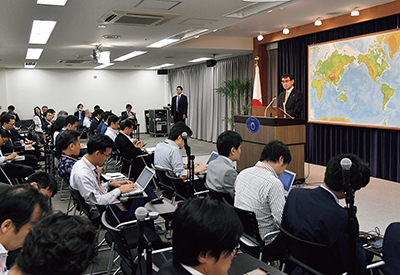 A Regular press conference (MOFA, Tokyo)
A Regular press conference (MOFA, Tokyo)When media report factual errors and insufficient information, MOFA reacts with an appeal for correction, contributes its views, and posts its views on the website of MOFA upon announcement at a press conference. With these efforts, MOFA strives for gaining an accurate understanding of Japan's policy in the world.

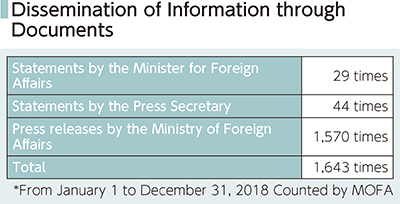
(3) Information Provision through the Internet
MOFA's website (Japanese and English) is a way to promptly provide information on the diplomatic activities of the Prime Minister and the Foreign Minister, as well as on Japan's foreign policy including territorial integrity, recognition of history, security, along with the latest international relations and other basic relevant information. MOFA's website in the Japanese language enjoys a wide range of contents including introductory ones on diplomacy such as “Easy Ways to Understand International Situations,” and “MOFA for Kids” for elementary and junior/senior-high school students.
MOFA also utilizes social media platforms including Facebook, Twitter, and YouTube.
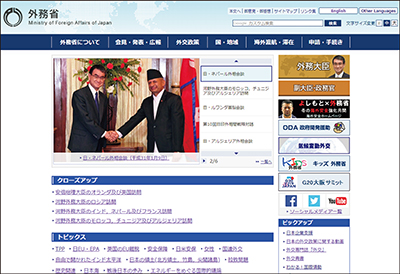 MOFA's Official Website
MOFA's Official Website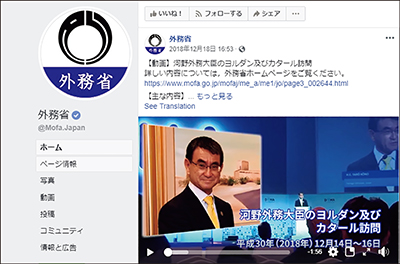 MOFA's Official Facebook Page
MOFA's Official Facebook Page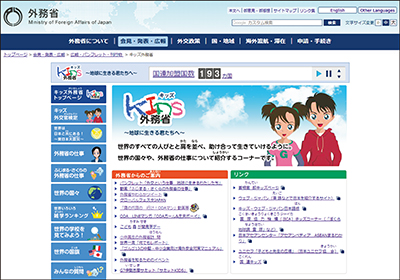 “MOFA for Kids”
“MOFA for Kids”(4) Dialogue with Japanese Nationals
With the notion of “Public Relations through Dialogue,” MOFA provides the people of Japan with an opportunity to directly talk to the Minister for Foreign Affairs, State Minister for Foreign Affairs, Parliamentary Vice-Minister for Foreign Affairs, and its officials. Such occasions include the events titled “Talk to the Minister,” in which the Foreign Minister engages in direct dialogue with the public to give straightforward explanations on Japan's foreign policies, and other themes of high interest among people, and answer questions and opinions.
MOFA also participates in “Home Town Talks,” in which, the three highest ranking officials of various ministries and governmental agencies talk with the residents of local Japanese areas. In 2018, Parliamentary Vice-Minister for Foreign Affairs Iwao Horii visited Kurashiki City of Okayama Prefecture in April, and Parliamentary Vice-Minister for Foreign Affairs Okamoto visited Iiyama City of Nagano Prefecture in September, giving explanations on the MOFA's policies, and exchanged opinions with the participants.
MOFA reaches out various age groups holding “Lectures on the International Situations,” “Diplomatic Talks,” and “Talks for High School Programs,” by sending its officials to venues such as international exchange organizations, universities and high schools throughout Japan. MOFA attaches importance on promoting better understandings in foreign policy and international affairs among youth, who are going to bear the future of Japan on their shoulders. With the notion in mind, MOFA holds the “International lssue Presentation Contest” for university students, and debate sessions between university students and young officials of the ministry through “Dialogue with Students,” as well as providing opportunities for young students to visit MOFA under the program “Visits by elementary, junior and senior-high school students to MOFA.”
 “International Issue Presentation Contest” (September 22, Nihonbashi Social Education Center, Tokyo)
“International Issue Presentation Contest” (September 22, Nihonbashi Social Education Center, Tokyo)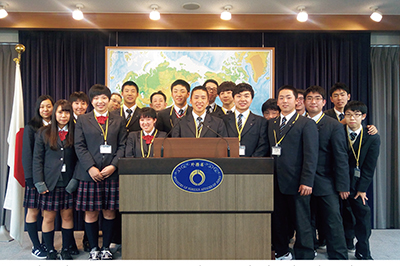 Visits by elementary, junior and senior-high school students to MOFA: Students from Sapporo Otani High School (Hokkaido) (November 23, Tokyo, MOFA)
Visits by elementary, junior and senior-high school students to MOFA: Students from Sapporo Otani High School (Hokkaido) (November 23, Tokyo, MOFA)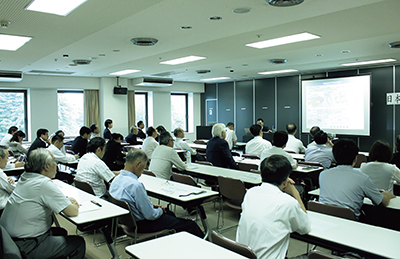 Lecture on the International Situation (July 5, El Park Sendai Seminar Hall, Miyagi Prefecture)
Lecture on the International Situation (July 5, El Park Sendai Seminar Hall, Miyagi Prefecture)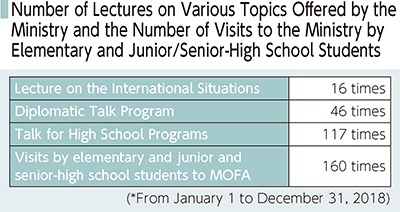
MOFA also introduces Japan's ODA policies and specific measures to the public through various symposia, lectures, and “ODA Delivery Lectures” in which MOFA officials take part. (31 lectures in 2018).
Additionally, MOFA publishes the periodical journal “Diplomacy,” sharing information on discussions taking place in various areas and at various levels concerning diplomacy and international affairs relevant to Japan widely. In 2018, the journal featured numerous papers written by renowned domestic and overseas experts on a variety of foreign diplomacy issues, including “public diplomacy” and a “Free and Open Indo-Pacific.”
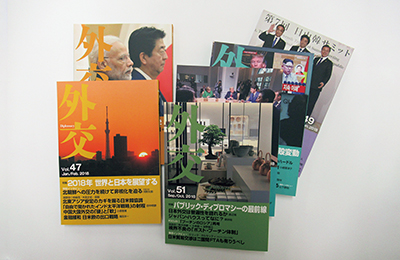 Journal on foreign affairs entitled “Diplomacy”
Journal on foreign affairs entitled “Diplomacy”Moreover, MOFA also makes various pamphlets in order to promote further understanding on the organizational structure and foreign policies of MOFA in an understandable manner. In addition to the above, MOFA accepts individual public opinions through various ways, including the website of MOFA, the office of the Prime Minister of Japan, and the web system of e-Government Public Comment Procedure (“e-Gov”). Comments and opinions from the public are accordingly shared in MOFA and used as a reference in policy making and planning.
(5) Promotion of the Declassification of Diplomatic Records and Access to Information
To further enhance the public understanding of and confidence in Japan's foreign policy, MOFA is actively engaging itself in the smooth transfer of records and their declassification. In addition, MOFA has been engaged in efforts to facilitate greater convenience in the public use of diplomatic documents.
MOFA preserves more than 120,000 historical materials, including 40,000 prewar historical documents in its Diplomatic Archives and has declassified its postwar diplomatic records since 1976 as a voluntary initiative. The Rules on the Declassification of Diplomatic Records, which were established in May 2010, stipulate: (1) the declassification of diplomatic documents created more than 30 years ago in principle and (2) the establishment of the “Committee for the Promotion of the Declassification of the Diplomatic Records” which is chaired by the Parliamentary Vice-Minister for Foreign Affairs as well as attended by external experts, to further promote the declassification of diplomatic records and improve its transparency. The number of files which have been transferred to the Diplomatic Archives and made public since then has reached approximately 31,000 by the end of 2018.
Furthermore, MOFA discloses information pursuant to the Act on Access to Information Held by Administrative Organs, while giving considerations to national security, the relationship of mutual trust with other countries, the impact on diplomatic negotiations, and the protection of personal information. In 2018, MOFA received 560 requests for disclosure, and the documents totaling 79,528 pages were disclosed.
 Exhibition poster
Exhibition posterIn 2018 the Ministry of Foreign Affairs (MOFA) held exhibitions to look back on Japan's Meiji era diplomacy with historical documents preserved at the Diplomatic Archives, in commemoration of the 150th anniversary of the Meiji Restoration (1868).
The Diplomatic Archives is a MOFA facility for preservation, management, and use of Japan's diplomatic historical materials since the end of the Edo era. The Special Exhibition “Japanese Diplomacy in the Meiji Era as Reflected in Sovereign and Personal Letters” was held from January 11 to May 31 at the Annex of the Diplomatic Archives. This exhibition displayed sovereign letters and personal letters sent from the heads of foreign countries to His Majesty the Emperor Meiji with particular importance for diplomatic history, including the credentials of British Minister to Japan, Harry Smith Parkes, (sent from Her Majesty Queen Victoria in 1868, giving recognition to the legitimacy of the Meiji Government) and the commission of full powers to Chinese plenipotentiary Li Hongzhang, which was brought to the Peace Conference of Sino-Japanese War in 1895 (a sovereign letter from Qing Emperor Guangxu).
Following this, the Diplomatic Archives held the Special Exhibition “Japanese Diplomacy in the Meiji Era as Reflected in Treaties” from June 12 to October 11. In this exhibition, the Treaty for the Exchange of Sakhalin for the Kurile Islands (signed document), the Anglo-Japanese Treaty of Commerce and Navigation which successfully eliminated consular jurisdiction, the Treaty of Shimonoseki, the Portsmouth Peace Treaty and other well-known treaties that appear in school textbooks were displayed.
Many positive opinions were received from the visitors, such as “I was moved by seeing the originals of these precious historical documents,” “This was a reminder of the importance of diplomacy,” “I admire the efforts of so many people that I was able to feel from the exhibition” and so on. There were also some voices requesting the use of pictures and explanatory notes pertaining to the exhibits as teaching materials.
Responding to the requests that the historical materials should be displayed in other regions, the Diplomatic Archives held the Joint Exhibition “Hokkaido in the Context of World History” together with the Archives of Hokkaido, from July 24 to August 23. Commemorating the 150th anniversaries of Hokkaido and the Meiji era, this exhibition put on display treaties related to the history of Hokkaido, such as the Treaty for the Exchange of Sakhalin for the Kurile Islands (instruments of ratification). This was the first exhibition of these documents in Hokkaido and about 19,000 people visited. Many visitors appreciated that they were blessed with the opportunity to see the originals of precious historical documents in Hokkaido.
In addition, the Diplomatic Archives held the Joint Exhibition “Japanese Diplomacy in the Meiji Era as Reflected in Diplomatic Records” in cooperation with the Kagoshima Prefectural Museum of Culture Reimeikan from November 6 to December 16. During this period, the “Segodon” Exhibition, which was synchronized with a TV history drama describing the life of Saigo Takamori (1827-1877), also took place at the museum. The exhibition offered an opportunity to learn more about the Meiji era through the Diplomatic Archives documents along with the materials in the Reimeikan museum.
For the convenience of those who did not have a chance to visit the exhibition, the Diplomatic Archives made available digital archives, the Exhibition “Japanese Diplomacy in the Meiji Era as Reflected in Sovereign and Personal Letters” on its website in December. This archives enabled anyone to view the exhibition anytime and anywhere, and also to see letters and characters, seals, patterns, and other unique details in various documents from other countries through the screen.
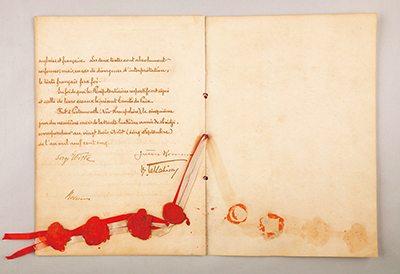 The Portsmouth Peace Treaty (signed document)
The Portsmouth Peace Treaty (signed document)These exhibitions commemorating the 150th Anniversary of the Meiji Restoration introduced Japan's trial-and-error process of modernization. Opening itself to the world at the end of the Edo era, Japan started building up international relations in the Meiji years, tackling various challenges, such as establishing diplomatic relations with other countries, border demarcation, and revision of unequal treaties. After the subsequent Sino-Japanese war (1894-95) and Russo-Japanese war (1904-1905), Japan reached a position equal to Western powers. We hope that these exhibitions provided a broad picture of Japan's diplomatic history, and an opportunity to think of Japanese foreign policy in the future. MOFA will continue to make efforts to promote public understanding of Japanese diplomacy by preserving, managing and encouraging the use of important historical documents.

